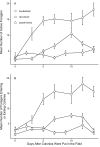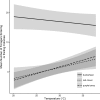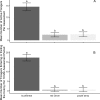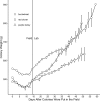Comparison of buckwheat, red clover, and purple tansy as potential surrogate plants for use in semi-field pesticide risk assessments with Bombus impatiens
- PMID: 27478712
- PMCID: PMC4950535
- DOI: 10.7717/peerj.2228
Comparison of buckwheat, red clover, and purple tansy as potential surrogate plants for use in semi-field pesticide risk assessments with Bombus impatiens
Abstract
Background. Bumble bees (Bombus spp.) are important wild and managed pollinators. There is increased interest in incorporating data on bumble bees into risk assessments for pesticides, but standardized methods for assessing hazards of pesticides in semi-field and field settings have not yet been established for bumble bees. During semi-field studies, colonies are caged with pesticide-treated flowering surrogate plants, which must be attractive to foragers to ensure colony exposure to the test compound, and must produce an ample nectar and pollen to sustain colonies during testing. However, it is not known which plant(s) are suitable for use in semi-field studies with bumble bees. Materials and Methods. We compared B. impatiens foraging activity and colony development on small plots of flowering buckwheat (Fagopyrum esculentum, var. common), red clover (Trifolium pratense), and purple tansy (Phacelia tanacetifolia) under semi-field conditions to assess their suitability as surrogate plants for pesticide risk assessment studies with bumble bees. We also compared the growth characteristics and input requirements of each plant type. Results. All three plant types generally established and grew well. Red clover and purple tansy experienced significant weed pressure and/or insect pest damage. In contrast, pest pressure was extremely low in buckwheat. Overall, B. impatiens foraging activity was significantly greater on buckwheat plots than red clover or purple tansy, but plant type had no effect on number of individuals produced per colony or colony weight. Discussion. Because of the consistently high foraging activity and successful colony development observed on buckwheat plots, combined with its favourable growth characteristics and low maintenance requirements, we recommend buckwheat as a surrogate plant for use in semi-field pesticide toxicity assessments with B. impatiens.
Keywords: Bumble bee; Colony development; Foraging; Method development; Pesticide risk assessment; Semi-field.
Conflict of interest statement
The authors declare there are no competing interests.
Figures




Similar articles
-
Potential surrogate plants for use in semi-field pesticide risk assessment with Megachile rotundata.PeerJ. 2019 Jan 18;6:e6278. doi: 10.7717/peerj.6278. eCollection 2019. PeerJ. 2019. PMID: 30687587 Free PMC article.
-
Hazards of insecticides to the bumble bees Bombus impatiens (Hymenoptera: Apidae) foraging on flowering white clover in turf.J Econ Entomol. 2002 Aug;95(4):722-8. doi: 10.1603/0022-0493-95.4.722. J Econ Entomol. 2002. PMID: 12216812
-
The Health of Commercial Bombus impatiens (Hymenoptera: Apidae) Colonies After Foraging in Florida Watermelon and Blueberry.Environ Entomol. 2019 Sep 30;48(5):1197-1202. doi: 10.1093/ee/nvz081. Environ Entomol. 2019. PMID: 31237607
-
Mechanistic modeling of pesticide exposure: The missing keystone of honey bee toxicology.Environ Toxicol Chem. 2017 Apr;36(4):871-881. doi: 10.1002/etc.3661. Epub 2016 Dec 16. Environ Toxicol Chem. 2017. PMID: 27769096 Review.
-
Behavioural effects of pesticides in bees--their potential for use in risk assessment.Ecotoxicology. 2003 Feb-Aug;12(1-4):317-30. doi: 10.1023/a:1022575315413. Ecotoxicology. 2003. PMID: 12739878 Review.
Cited by
-
Development of a test design for a semi-field, colony-feeding study for the common eastern bumble bee (Hymenoptera: Apidae).Environ Entomol. 2025 Jun 18;54(3):544-552. doi: 10.1093/ee/nvaf020. Environ Entomol. 2025. PMID: 40257484 Free PMC article.
-
Results of Ring-Testing of a Semifield Study Design to Investigate Potential Impacts of Crop Protection Products on Bumblebees (Hymenoptera, Apidae) and a Proposal of a Potential Test Design.Environ Toxicol Chem. 2022 Oct;41(10):2548-2564. doi: 10.1002/etc.5430. Epub 2022 Aug 24. Environ Toxicol Chem. 2022. PMID: 35815475 Free PMC article.
-
Comparison of Pesticide Exposure in Honey Bees (Hymenoptera: Apidae) and Bumble Bees (Hymenoptera: Apidae): Implications for Risk Assessments.Environ Entomol. 2019 Feb 13;48(1):12-21. doi: 10.1093/ee/nvy168. Environ Entomol. 2019. PMID: 30508078 Free PMC article.
-
Potential surrogate plants for use in semi-field pesticide risk assessment with Megachile rotundata.PeerJ. 2019 Jan 18;6:e6278. doi: 10.7717/peerj.6278. eCollection 2019. PeerJ. 2019. PMID: 30687587 Free PMC article.
References
-
- Bartomeus I, Potts SG, Steffan-Dewenter I, Vaissiere BE, Woyciechowski M, Krewenka KM, Tscheulin T, Roberts SPM, Szentgyorgyi H, Westphal C, Bommarco R. Contribution of insect pollinators to crop yield and quality varies with agricultural intensification. PeerJ. 2014;2:e2228. doi: 10.7717/peerj.328. - DOI - PMC - PubMed
-
- Brittain C, Potts SG. The potential impacts of insecticides on the life-history traits of bees and the consequences for pollination. Basic and Applied Ecology. 2011;12:321–331. doi: 10.1016/j.baae.2010.12.004. - DOI
-
- Cabrera AR, Almanza MT, Cutler GC, Fischer DL, Hinarejos S, Lewis G, Nigro D, Olmstead A, Overmyer J, Potter DA, Raine NE, Stanley-Stahr C, Thompson H, Der Steen J. Initial recommendations for higher-tier risk assessment protocols for bumble bees, Bombus spp. (Hymenoptera: Apidae) Integrated Environmental Assessment and Management. 2016;12:222–229. doi: 10.1002/ieam.1675. - DOI - PubMed
-
- Carreck NL, Williams IH. Food for insect pollinators on farmland: insect visits to flowers of annual seed mixtures. Journal of Insect Conservation. 2002;6:13–23. doi: 10.1023/A:1015764925536. - DOI
LinkOut - more resources
Full Text Sources
Other Literature Sources
Miscellaneous

